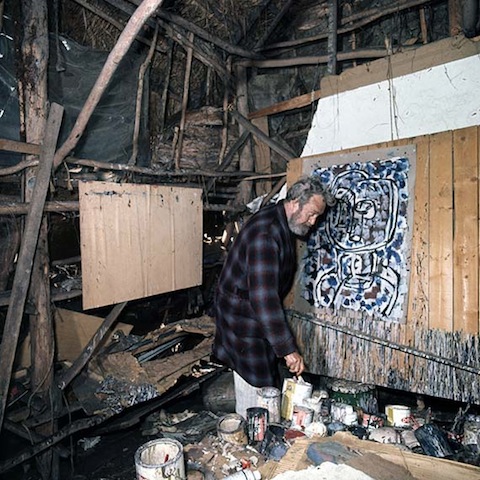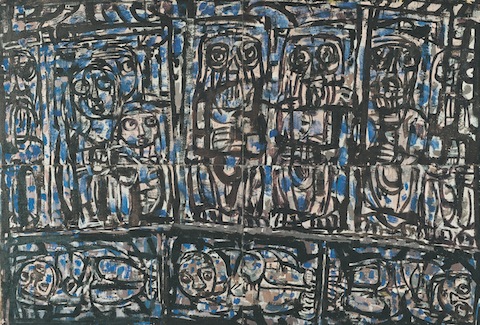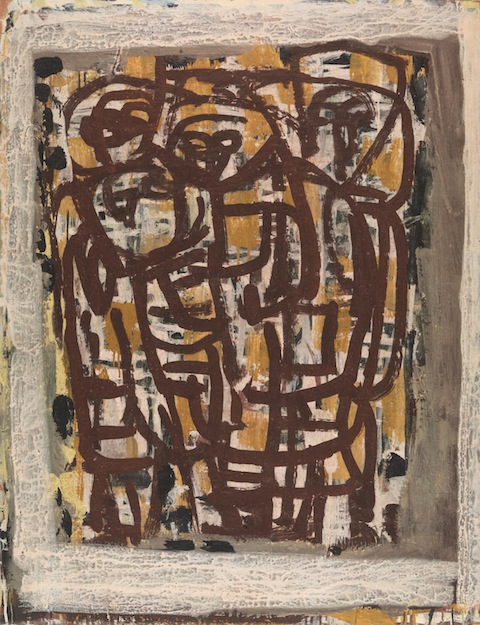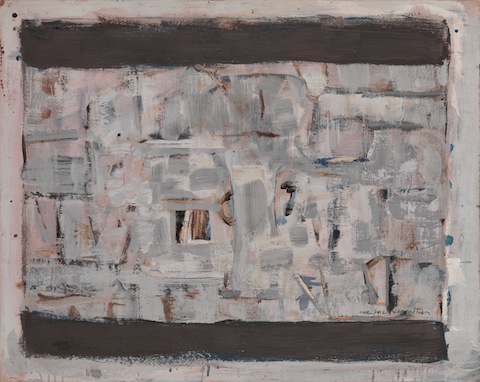
Ian Fairweather: Late Works

Above: Ian Fairweather painting in his studio on Bribie Island, 1972 | National Archives of Australia: A6135, K24/11/72/1
Running alongside the APT7, in the Xtrata Coal Queensland Artists’ Gallery at QAG is Ian Fairweather: Late Works 1953-74. This is a much smaller exhibition, restricted in scope to one artist, and likely to attract less publicity. It is, however, a profound viewing experience. It’s also intended to function in conversation with the Triennial.
Fairweather travelled widely, adventurously and almost continuously during his youth. Born in Scotland, he grew up on the island of Jersey, survived four and a half years as a German prisoner of war, studied art at the Slade School in London, emigrated to Canada and then to Australia via China and Bali, survived a second world war, lived for periods of time in India and the Philippines. Indigenous art, and Asian cultures and landscapes – particularly China – were tangible influences. He lived in Peking. Sailed a hand built raft from Darwin across the Timor Sea. Not until the ripe age of 61 did he actually settle.
In 1953 he moved to Bribie Island in Queensland’s Moreton Bay, then sparsely inhabited and only accessible to the mainland by boat. He stayed there until his death in 1974. In the definitive book on the artist, titled simply Fairweather, author Murray Bail describes his lodgings thus: “On Bribie Island, Fairweather had set himself up off the main road, a mile or two from the shops and post office. A bushfire had swallowed his tent and all of his belongings, including the Chinese dictionary, and in the stillness of the blackened forest he built a hut of poles thatched with grass. For the rest of his days he would never enjoy the comforts of running water, of sewage and electricity; if he painted at night it would be with the erratic assistance of a hurricane lamp. He made chairs and a bed upholstered in ferns …”
Fairweather was 63 at that point, living in solitude, painting day and night, re-imagining faraway landscapes. As a teenager growing up, fascinated by Murray Bail’s impressive monograph, I thought of the artist as a genuine hermit, completely cut off from the outside world. In the catalogue to this new exhibition curator Angela Goddard slightly debunks this myth. She takes pains to point out that while Fairweather did indeed live in rustic seclusion, he was far from isolated. A well-educated man, he was in frequent correspondence with friends and colleagues, read widely and subscribed to a number of journals and magazines including The Times Literary Supplement and Time Magazine. However, his carefully protected solitude and strangely humble way of existence was real. During these years Fairweather produced the finest paintings of his life.

Above: Ian Fairweather; Scotland / Australia 1891 - 1974; Epiphany 1962; Synthetic polymer paint; 139.6 x 203.2cm. Collection: Queensland Art Gallery
Ian Fairweather: Late Works is a carefully considered, sensitive, understated show. It’s quietly wonderful. Thirty-one paintings are arranged simply around the walls, the powerful Gethsemane (on loan from the collection of Philip Bacon, the painting was once owned by Nobel Prize winning novelist Patrick White and hung above his desk) and QAG’s own Epiphany stars among them. In the centre of the room are some display cases where sketches and photographs and letters are revealed. Books – the Drunken Buddha is one (Fairweather translated the tale from the Chinese and it is illustrated with 12 of his paintings) are stacked in a pile to be leafed through. There is nothing theatrical about this room. It is, like Fairweather’s work, an essay in subtlety. (I missed the headphones entirely, and luckily could access the audio component online through QAG’s link to the Hazel de Berg sound archives at the National Library, short poignant recordings of Fairweather talking about his art practice and life history – it’s quite something to hear his voice and views.)

Above: Ian Fairweather; Scotland / Australia 1891 - 1974; Chi-tien drunk - carried home 1964; Synthetic polymer paint and gouache; 91 x 71cm. Gift of the Josephine Ulrick and Win Schubert Foundation for the Arts through the Queensland Art Gallery Foundation 2012. Donated through the Australian Government’s Cultural Gifts Program. Collection: Queensland Art Gallery
It’s easy to spend an hour in here, or much longer, immersed in the imaginative world of this genuinely eccentric figure and the shifting, reverential, beautifully coloured, fragile, multi-layered surfaces of his most celebrated paintings. The artist took months or even years to complete a painting, and he frequently worked on more than one work at a time. “Painting to me is a tightrope act – its between representation and the other thing, whatever that is – it’s difficult to keep one’s balance,” he said. As the years went on, he had no need to carry around a sketchpad or to see new places. When he was younger he painted many subjects, by the late years, there was really just one subject that he painted over again – “People”. Meaning the wider sense: humanity.

Above: Ian Fairweather; Scotland / Australia 1891 - 1974; Painting III 1960; Synthetic polymer paint and gouache on cardboard on hardboard; 71 x 89cm. Purchased 1998. The Queensland Government's special Centenary Fund. Collection: Queensland Art Gallery.
Fairweather never attended his exhibitions and rarely gave interviews, yet collectors queued up outside Sydney’s Macquarie Galleries to buy his work. He was a huge figure in the Australian art world, then and now, and his influence on other artists is far-reaching.
The last word goes to Bail (these are final words in his book): “Fairweather is the least parochial of Australian painters, an artist of exceptional force and originality. Due to the nature of things, reticence and distance on Fairweather’s part, the rest of the world scarcely knew, or even knows now, of his existence.”
- Susie Burge, all rights reserved.
Images courtesy Queensland Art Gallery.
Ian Fairweather: Late Works 1953-74 runs 3rd Nov 2012 to 3rd March 2013 at Queensland Art Gallery, Brisbane
The catalogue to the show published by QAG is informative, lovely to leaf through and collectable.
Murray Bail’s doorstopper of a book, Ian Fairweather, first published in 1981 has been reissued in a handsome new edition by Murdoch Books.